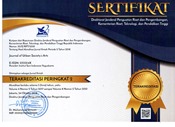Typological Analysis of Metalhead Community’s Logo as Visual Communication During Covid-19 Pandemic
Abstract
Typology Analysis of Metalhead Community Logos as Visual Communication During the Covid-19 Pandemic. The Covid-19 pandemic brought many changes in terms of how to communicate within the community, namely Metalhead, both nationally and internationally by utilizing social media Facebook, Instagram, and so on through logos and graphic designs. The research problem is the tendency to use a logo which is the hallmark of the Metalhead group in terms of typography and function. Qualitative research methods with observational data collection, literature review, and documentation. The approach using typology studies includes typography and function. The findings from the results of the study show that the metalhead logo typology through digital posters has its own characteristics, in color selection, the dominant use of white in writing and the background tends to be dark in color, namely black, red, and other colors but not so dominating. Regarding letters, they tend to use unusual letters (design themselves) in writing band names. Event themes, schedules, venues, and sponsors tend to use fonts that are universally understood or still use conventional fonts in Microsoft Word. The function of the metalhead logo is to form a collective identity and communication among Metalheads and the wider community.
Analisis Tipologi Logo Komunitas Metalhead sebagai Komunikasi Visual Selama Pandemik Covid-19. Masa pandemi Covid-19 membawa banyak perubahan dalam hal cara berkomunikasi di ranah komunitas yaitu Metalhead, baik secara nasional maupun internasional dengan memanfaatkan media sosial Facebook, Instagram, dan lain sebagainya lewat logo dan desain gambar. Permasalahan penelitian adalah kecenderungan penggunaan logo yang menjadi ciri khas kelompok Metalhead dalam ragam tipografi dan fungsi. Metode penelitian kualitatif dengan pengumpulan data secara observasi, kajian kepustakaan, dan dokumentasi. Pendekatan menggunakan studi tipologi mencakup tipografi dan fungsi. Temuan dari hasil penelitian memperlihatkan bahwa tipologi logo Metalhead lewat poster digital memiliki kekhasan tersendiri, dalam pemilihan warna, dominan menggunakan warna putih dalam tulisan dan latar belakang cenderung berwarna gelap yaitu hitam, warna merah, dan warna lainnya tetapi tidak begitu mendominasi. Terkait huruf, cenderung menggunakan huruf yang tidak lazim (mendesain sendiri) dalam menuliskan nama band. Tema acara, jadwal, tempat, dan sponsor cenderung menggunakan huruf yang dapat dimengerti secara universal atau masih menggunakan huruf-huruf konvensional dalam Microsoft Word. Fungsi logo Metalhead sebagai pembentuk identitas kolektif dan komunikasi di antara sesama Metalhead serta masyarakat luas.
Keywords
Full Text:
PDFReferences
A. S. Hornby. (2002). Oxford Advanced Learners Dictionary (Pengertian Heritage). In Dictionary (p. 202). Oxford University Press.
Ajidarma, S. G. (2021). Ngobrolin Komik. Yogyakarta: Pabrik Tulisan.
Akbar, T., & Raden, A. Z. (2016). Tipografi Vernakular pada Warung Tenda Kaki Lima Jakarta. Dimensi DKV Seni Rupa Dan Desain, 175–183.
Anderson, B. (2008). Imagined Communities: Komunitas-Komunitas Terbayang (O. I. Naomi, Ed.). Yogyakarta: Insist Press.
Barker, C., & Galasinski, D. (2001). Cultural Studies and Discourse Analysis. London: SAGE Publications.
Capper, A., & Sifre, G. (2009). Heavy Metal in Baghdad: The Story of Acrassicauda. New York: Simon and Schuster.
Carter, D. E. (1985). Designing Corporate Identity Programs for Small Corporation. New York: Art Direstion Book Company.
Dobie, M. I. (2001). The Impact of New Technologies and the Internet on the Music Industry, 1997-2001 (University of Salford). Retrieved from https://core.ac.uk/download/105017.pdf
Finlayson, G. (2005). Habermas: A Very Short Introduction. Oxford: Oxford University.
Given, L. M. (2008). The SAGE Encyclopedia of Qualitative Research Methods. https://doi.org/https://dx.doi.org/10.4135/9781412963909
Habermas, J. (1984). The Theory of Communicative Action Vol. 1: Reason and the Razionalization of Society. Boston: Beacon Press.
Howard, P. (2003). Heritage: Management, Interpretation, Identity. London: A&C Black (Bloomsbury Publishing).
Irawati, E. (2020). Transmisi, Musik Lokal-Tradisional, dan Musik Populer. Jurnal Panggung, 30(3). Retrieved from http://dx.doi.org/10.26742/panggung.v30i3.893
Irawati, E. (2021). Transmisi, Kesinambungan & Ekosistem Kunci ‘Musik Tradisi.’ Yogyakarta: Art Music Today.
Jones, C. P. (2000). Investments: Analysis and Management (7th ed.). New York: John Wiley & Sons.
Jubilee Enterprise. (2015). Membuat Company Profile: Cara Mudah Membuat Presentasi Profil Perusahaan dan Personal Branding. Jakarta: Elex Media Komputindo.
Mazierska, E. (2018). Popular Viennese Electronic Music, 1990-2015: A Cultural History. London: Routledge.
McIntyre, D. P., & Srinivasan, A. (2017). Networks, Platforms, and Strategy: Emerging Views and Next Steps. Strategic Management Journal, 38(1), 141–160. Retrieved from https://doi.org/10.1002/smj.2596
Murphy, J., & Michael, R. (1998). How to Design Trademarks and Logos. Ohio: North Light Book.
Nurmalinda. (2021). Symbolic Interactinism in Ceremonies of Ritual Medicine in Malay Society in Riau Province. Journal of Urban Society’s Arts, 8(2), 98–110. Retrieved from https://doi.org/10.24821/jousa.v8i2.5719
Rahmat, S. P. N. (2017). Musik Metal dan Nilai Religius Islam: Tinjauan Estetika Musik Bermuatan Islami dalam Penampilan Purgatory. Resital: Jurnal Seni Pertunjukan, 18(3), 133–143.
Sholahuddin, M. (2021). Potensials Interior Design to Meet Cultural Needs Transformed by Covid-19 Pandemic by Interior Designer in Yogyakarta. Journal of Urban Society’s Arts, 8(2), 111–123. Retrieved from https://doi.org/10.24821/jousa.v8i2.4614
Sihombing, D. (2015). Tipografi dalam Desain Grafis. Jakarta: Gramedia Pustaka Utama.
Soewardikoen, D. W. (2015). Visualisasi Iklan Indonesia Era 1950-1957. Yogyakarta: Calpulis.
Stokes, J. (2003). How To Do Culture & Media Studies. London: SAGE Publications.
Tinarbuko, S. (2012). Semiotika Komunikasi Visual (Revisi). Yogyakarta: Jalasutra.
Weinstein, C. E., Husman, J., & Dierking, D. R. (2000). Self-Regulation Interventions with a Focus on Learning Strategies. In M. Boekaerts, P. R. Pintrich, & M. Zeidner (Eds.), Handbook of Self-Regulation (pp. 727–747). Retrieved from https://doi.org/10.1016/B978-012109890-2/50051-2
Weinstein, D. (2000). Heavy Metal: The Music and Its Culture. New York: Perseus Books Group.
DOI: https://doi.org/10.24821/jousa.v9i1.7073
Refbacks
- There are currently no refbacks.

This work is licensed under a Creative Commons Attribution 4.0 International License. ISSN 2355-2131 (print) | ISSN 2355-214X (online).







